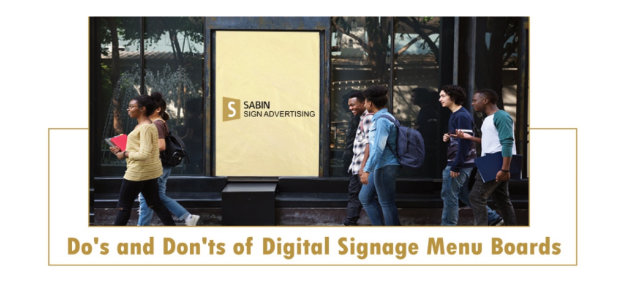
Do’s and Don’ts of Digital Signage Menu Boards
More and more restaurants are making the switch to digital menu boards. These high-tech displays offer a number of advantages over traditional printed menus. They allow you to easily update prices, highlight specials, display brilliant images of dishes, and even run promotional videos.
However, with the flexibility of digital signage comes the potential for certain pitfalls. Follow this guide on the do’s and don’ts of digital menu boards to create an effective system that drives sales.
- Choose the Right Display Type
Digital signage comes in a wide range of forms, from small tabletop tablets to massive video walls. When selecting displays, match the scale and specs to your environment. Consider viewing distances, light conditions, and mounting requirements.
For most restaurants, standard commercial-grade LCD panels around 43–55 inches work well. They balance visibility, resolution, brightness, and cost. Go bigger for spaces with longer sight lines, like cafeterias. Add special coatings and enclosures for outdoor menu boards.
- Don’t Skimp on Processing Power
The brains behind your digital signage system are the media players. This small box streams content from your CMS to displays. When speaking, players should prioritize RAM, storage, and graphics capabilities.
Underpowered media appliances lead to stuttering video, crashes, and other playback issues that reflect poorly on your brand. A robust commercial player designed for 24/7 operation brings reliability. For demanding applications with many zones or multiple synchronized 4K feeds, choose a server-grade option.
- Do Design for Readability
Legible text and images are crucial for digital menus. But with higher resolutions and wider screens, it’s tempting to add more elements that end up cluttering. Stick to core information like prices, descriptions, and photos, and opt for simple, modern fonts.
Maintain strong contrast between background colors and text. Key details should pop through at a glance. Consistent styling also aids quick scanning, so guests can find what they want faster among the pages of options.
- Don’t Neglect Interactivity
Digital signage introduces opportunities for playful interactivity to engage guests. Integrate order-at-table solutions to enable direct ordering from screens. Allow diners to browse menus in detail, build custom orders, split checks, and even play games while waiting.
Kiosks and tabletop tablets also encourage interactivity. Their compact size suits deployment throughout dining areas for closer access. Just remember to craft a cohesive experience across all touchpoints.
- Do Show Specials Creatively
An ace up your sleeve with digital boards is promoting daily specials and new items in eye-catching ways. Animated graphics, parallax effects, transitions, and movement attract attention to the best deals and dishes.
When featuring specials, don’t just list items and pricing. Combine dynamic imagery, inspiring descriptions, chef profiles, behind-the-scenes kitchen views and more. Turn promos into memorable mini-stories.
- Don’t Stick to Static Screens
A common misconception is that digital signage simply replaces print. However, static pages with no visual flair fail to utilize the format’s potential. Include motion, animated elements, transitions, and videos, even for subtle dynamism.
When displaying single images like food photos, apply subtle Ken Burns zooming and panning to add depth. Layer text over image carousels. Break longer static sections with brief interstitial videos. Every element doesn’t have to move: just incorporate activity into the experience.
- Do Design for Quick Glances
Remember that most diners only glance at menus briefly while in line or approaching registers. Key details should jump out right away. Prioritize hero images of signature dishes and emphasize pricing.
Minimize dense blocks of text unlikely to be read mid-browse. For supporting content, succinctly highlight origin stories, ingredients, etc. using bullet points, icons and call-outs. Arrange items clearly under sections, allowing easy visual scanning at speed.
- Don’t Overwhelm Viewers
On the flip side, cramming digital menus with endless animated elements risks overstimulation. When visitors first approach your boards, they need an obvious visual hierarchy guiding them to crucial details like prices or daily specials.
Ensure key points stand out clearly instead of blending into the spectacle. Avoid complex data visualizations unless they depict easily grasped insights. And don’t underestimate negative space; occasional pauses guide the eyes, allowing absorption before proceeding.
- Do Integrate scoring, but discreetly
Digital boards present opportunities for suggestive upsells and dynamic pricing optimizations. But overly manipulative tactics undercut trust in your brand. The key is moderation and transparency.
Discreet dynamic badging that politely indicates a dish’s popularity keeps suggestions friendly. Consider gentle animations guiding eyes down towards higher-margin selections. Just ensure competitive flagship dishes maintain a strong presence—don’t let the technology overshadow the food!
Conclusion
When thoughtfully implemented, digital menus boost operational efficiency, enable engaging guest experiences, and help restaurateurs tell their unique stories. Avoid common mistakes around displays, interactivity, and interactivity content design while playing to the format’s strengths. The technology might be cutting-edge, but the fundamentals of hospitality still apply—connect with visitors in memorable ways!
















